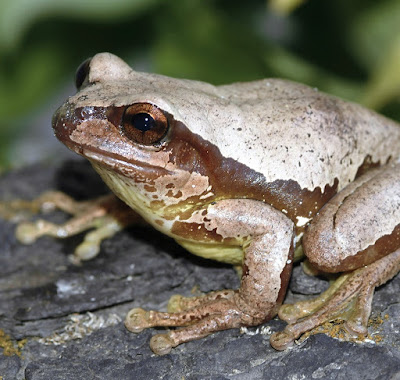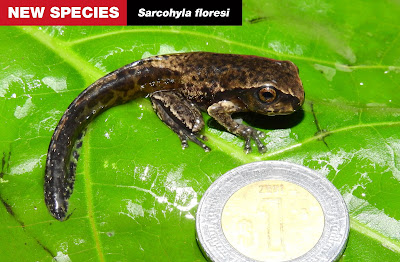[Most Recent Entries] [Calendar View]
Tuesday, March 3rd, 2020
| Time | Event | ||||
| 2:22a | [Herpetology • 2020] Dragons in Neglect: Taxonomic Revision of the Sulawesi Sailfin Lizards of the Genus Hydrosaurus Kaup, 1828 (Squamata, Agamidae)
Abstract Currently three different species are recognized within the Southeast Asian agamid genus Hydrosaurus: H. amboinensis (Schlosser, 1768) from Ambon, Seram, Sulawesi and New Guinea, H. pustulatus (Eschscholtz, 1829) from the Philippines and H. weberi Barbour, 1911 from Halmahera and adjacent islands. Historically, two additional species were described from the island of Sulawesi, but were synonymized with H. amboinensis more than a century ago and have been treated as such in most subsequent publications. In order to revise the taxonomy and diversity of these enigmatic agamid lizards, we examined the corresponding type specimens and additional material originating from Sulawesi and compared them to photographs of live specimens from field trips. Due to differences in colour pattern and scalation characters, we resurrect the taxa celebensis Peters, 1872 and microlophus Bleeker, 1860 from the synonymy of H. amboinensis, which in turn is restricted to the central Moluccas and New Guinea. Hence, Sulawesi is currently the only known island within the genus’ range to be inhabited by two different species of sailfin lizards. Our systematic investigation brings the number of recognized species within the genus Hydrosaurus to five. Keywords: Reptilia, Hydrosaurinae, Indonesia, type specimens, taxon resurrection, synonymy, distribution Wolfgang Denzer, Patrick D. Campbell, Ulrich Manthey, Andrea Glässer-Trobisch and André Koch. 2020. Dragons in Neglect: Taxonomic Revision of the Sulawesi Sailfin Lizards of the Genus Hydrosaurus Kaup, 1828 (Squamata, Agamidae). Zootaxa. 4747(2); 275–301. DOI: 10.11646/zootaxa.4747.2.3 | ||||
| 2:41p | [Botany • 2020] Cyanea kuhihewa: Rediscovering One of Hawai'i's Rarest Trees
Abstract Cyanea kuhihewa is a Hawaiian plant thought to be extinct but recently rediscovered. Oceanic island plants are uniquely adapted to their environment. Globally, many island species are now threatened needing extensive conservation management to survive. We highlight this global conservation challenge and provide an example from Hawai'i of how we may safeguard critically endangered species from extinction.
CONCLUDING REMARKS: The flora of Hawai'i is a hotspot of endemism, but the uniquely adapted native flora is highly vulnerable to disturbance, and losing just a few populations may mean losing one or more species. C. kuhihewa is one of about 85 taxa in this genus of charismatic Hawaiian lobeliads, most of which are uniquely adapted to a single island or are even narrower endemics from a single mountain or valley. About half of the genus is considered threatened, most of them with fewer than 50 individuals remaining in the wild. Reports of rediscovery of species previously thought to be extinct are always encouraging news, and we may still be able to safeguard C. kuhihewa through the ongoing combination of monitoring, weed and predator control, seed‐banking, propagation, and out‐planting. Nina Rønsted and Kenneth R. Wood. 2020. Cyanea kuhihewa: Rediscovering One of Hawai'i's Rarest Trees. PLANTS, PEOPLE, PLANET. DOI: 10.1002/ppp3.10099 twitter.com/PlantsPplPlanet/status/1229716541815521280 #FloraObscura | ||||
| 2:48p | [Herpetology • 2020] Sarcohyla floresi • A New Species of Sarcohyla (Anura: Hylidae: Hylini) from the Sierra Madre del Sur of Guerrero and Estado de México, México
Abstract We describe a new species of frog Sarcohyla floresi sp. nov. from the Sierra Madre del Sur of Guerrero and the southern part of Estado de México, based on specimens previously referred to as S. pentheter and newly obtained specimens. The new species has stream-dwelling tadpoles with labial tooth row formula 2(2)/3 and adults with a distinctive dark dorsolateral band bordered by a white line. S. floresi can be included in the S. bistincta group. Key words: Amphibia, Taxonomy, Sarcohyla pentheter, Sarcohyla floresi, Sarcohyla bistincta group
Sarcohyla floresi sp. nov. Etymology. This species is named after Oscar Flores Villela, a researcher and teacher at the Museo de Zoologia, Facultad de Ciencias, Universidad Nacional Autonoma de México, to recognize his life-long commitment to the science and conservation of amphibians and reptiles in México. Natural history. The holotype was found inside a fissure of a large boulder on a mountain crest far from a body of water. The type locality consists of dry deciduous forest characteristic of the Pacific slopes of the Sierra Madre del Sur of Guerrero (Rzedowski, 1978). All tadpoles were found during the day in pools formed in streams. Moises Kaplan, Peter Heimes and Rafael Aguilar. 2020. A New Species of Sarcohyla (Anura: Hylidae: Hylini) from the Sierra Madre del Sur of Guerrero and Estado de México, México. Zootaxa. 4743(3); 382–390. DOI: 10.11646/zootaxa.4743.3.5 Resumen: Describimos una nueva especie de rana Sarcohyla floresi sp. nov. de la Sierra Madre del Sur de Guerrero y la parte sur del Estado de México basado en especímenes previamente considerados S. pentheter así como especímenes recién colectados. La nueva especie tiene renacuajos con formula dental 2(2)/3 que viven en arroyos, y adultos con una banda dorsolateral oscura bordeada por una línea blanca. S. floresi puede ser incluida en el grupo S. bistincta. |
| << Previous Day |
2020/03/03 [Calendar] |
Next Day >> |















